The concept of a ceramic-polymer piezoelectric composite structure is found mainly in the forms known as “1-3 connectivity” and “2-2 connectivity”.
- In 1-3 connectivity, fine ceramic rods are coated with a polymer binding agent.
- In 2-2 connectivity, fine ceramic blades are coated with a polymer binding agent.
The properties of the resulting structure are linked to the properties of the constituent materials and to the geometric characteristics of the structure itself.
The design of a piezocomposite transducer makes use of the mechanical, electrical et piezoelectrical properties of a type 1-3 or 2-2 structure within a stack of passive layers (non-piezoelectric). This multi-layer structure is then interconnected and encapsulated to form a complete transducer, also known as a probe or applicator depending on the field of application.
